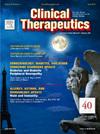右美托咪定-异丙酚与单独异丙酚在上消化道内镜超声中的镇静作用:一项随机比较研究。
IF 3.6
4区 医学
Q2 PHARMACOLOGY & PHARMACY
引用次数: 0
摘要
目的:上消化道超声内镜检查(EUS)在优化手术条件的同时,需要平衡的镇静以确保患者的安全。本研究在呼吸安全性、镇静质量和恢复结果方面评估右美托咪定-异丙酚与仅异丙酚镇静的安全性和有效性。方法:这项前瞻性随机对照试验纳入了2022年1月至2023年5月期间接受下食管或胃EUS治疗的145例患者。所有的参与者都接受了咪达唑仑和丁卡因凝胶的粘膜局部化的标准化预用药。参与者被随机分为两组:右美托咪定-异丙酚组(n = 72)和仅异丙酚组(n = 73)。连续变量分析采用独立t检验,分类资料比较采用卡方检验,P < 0.05为差异有统计学意义。结果:两组患者满意度差异无统计学意义(P = 0.717),但右美托咪定-异丙酚组内镜医师满意度显著高于右美托咪定组(P < 0.05)。该组患者咪达唑仑抢救剂量明显减少,呼吸不良事件明显减少,术中患者运动和咳嗽反射明显减少(P < 0.05)。此外,恢复结果得到改善,改进Aldrete评分较高,麻醉后出院评分≥9的实现更快(P < 0.05)。联合用药组诱导时间更长,低血压、心动过缓发生率较高(P < 0.05)。意义:右美托咪定-异丙酚镇静增强EUS的手术条件和恢复指标,但与更大的心血管副作用相关。这些发现表明,它是单独异丙酚的有价值的替代品,特别是在优化手术医师满意度和减少呼吸并发症时。本文章由计算机程序翻译,如有差异,请以英文原文为准。
Dexmedetomidine-Propofol Versus Propofol Alone for Sedation in Upper Gastrointestinal Endoscopic Ultrasound: A Randomized Comparative Study
Purpose
Upper gastrointestinal endoscopic ultrasonography (EUS) necessitates well-balanced sedation to ensure patient safety while optimizing procedural conditions. This study evaluates the safety and efficacy of dexmedetomidine-propofol versus propofol-only sedation in terms of respiratory safety, sedation quality, and recovery outcomes.
Methods
This prospective randomized controlled trial enrolled 145 patients undergoing lower esophageal or gastric EUS from January 2022 to May 2023. All participants received standardized premedication with midazolam and tetracaine gel for mucosal topicalization. Participants were randomized into two groups: dexmedetomidine-propofol (n = 72) and propofol-only (n = 73). Continuous variables were analyzed using independent t-tests, and categorical data were compared with chi-square tests, with statistical significance set at P < 0.05.
Findings
No significant difference was observed in patient satisfaction (P = 0.717), but endoscopist satisfaction was significantly higher in the dexmedetomidine-propofol group (P < 0.05). This group also showed significantly fewer midazolam rescue doses, fewer respiratory adverse events, and reduced intra-procedural patient movement and cough reflexes (all P < 0.05). Furthermore, recovery outcomes were improved, with higher modified Aldrete scores and faster achievement of a post-anesthesia discharge score ≥9 (P < 0.05). However, induction time was longer and the incidence of hypotension and bradycardia was higher in the combination group (P < 0.05).
Implications
Dexmedetomidine-propofol sedation enhances procedural conditions and recovery metrics in EUS but is associated with greater cardiovascular side effects. These findings suggest it is a valuable alternative to propofol alone, particularly when optimizing proceduralist satisfaction and minimizing respiratory complications.
求助全文
通过发布文献求助,成功后即可免费获取论文全文。
去求助
来源期刊

Clinical therapeutics
医学-药学
CiteScore
6.00
自引率
3.10%
发文量
154
审稿时长
9 weeks
期刊介绍:
Clinical Therapeutics provides peer-reviewed, rapid publication of recent developments in drug and other therapies as well as in diagnostics, pharmacoeconomics, health policy, treatment outcomes, and innovations in drug and biologics research. In addition Clinical Therapeutics features updates on specific topics collated by expert Topic Editors. Clinical Therapeutics is read by a large international audience of scientists and clinicians in a variety of research, academic, and clinical practice settings. Articles are indexed by all major biomedical abstracting databases.
 求助内容:
求助内容: 应助结果提醒方式:
应助结果提醒方式:


